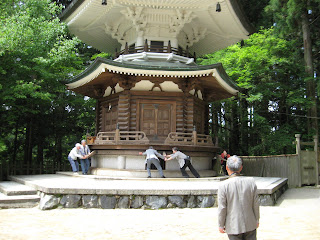For the last few weeks, all the stores in town have been selling yukata and all the accessories. All of us at Shirasagi decided to get in on the action! We all bought yukata and obi (about $30), and geta (shoes), and fans, purses, hair clips, etc. And yesterday some kind and patient Japanese friends came over to help us get dressed and to tie the obis (a real skill!).

Me and Taube being demure.



Julian and Rob earnestly discussing the finer points of Rob's umbrella...

Boarding the bus
Once we got all dolled up, we hopped on the local bus (which charged half price if you were wearing a yukata that day) and headed downtown for some group photos. First we stopped into Koko-en, the beautiful garden next to the castle and took photos of each other there.

Lyn posing prettily on walkway

Me and Sue on the bridge
Next we went on towards Himeji Castle where we had an appointment with a professional photographer. The clouds were ominous so we took some quick photos before the rain came. Just as we finished those, the rain started so we stood under the main castle gate until it let up. We managed to get another round of photos taken in front of the castle.

Showing off our obis

While we were doing that, many other people came around to take our photos too. It seemed everyone got a kick out of seeing the foreigners dressed up in yukata. We had our own personal paparazzi! We were asked to stay and to see the children’s parade so that the paparazzi could take our photos while we admired the parade! We didn’t know at the time who all was in the paparazzi bunch, but this morning I got an email from a friend that we were on the morning news!


As soon as the parade finished, the rain started again, so we beat a path to Miyuki-dori, a covered arcade (street filled with shops). Miyuki-dori was absolutely packed with people in yukata and booths selling street food and other carnival paraphernalia. We got separated but managed to meet up again for dinner at our favorite izukaya (happy hour place) and then did purikura (photo booth where you can decorate your photos afterwards).

The line for the purikura machine (the machine is the pink thing in the background)







































